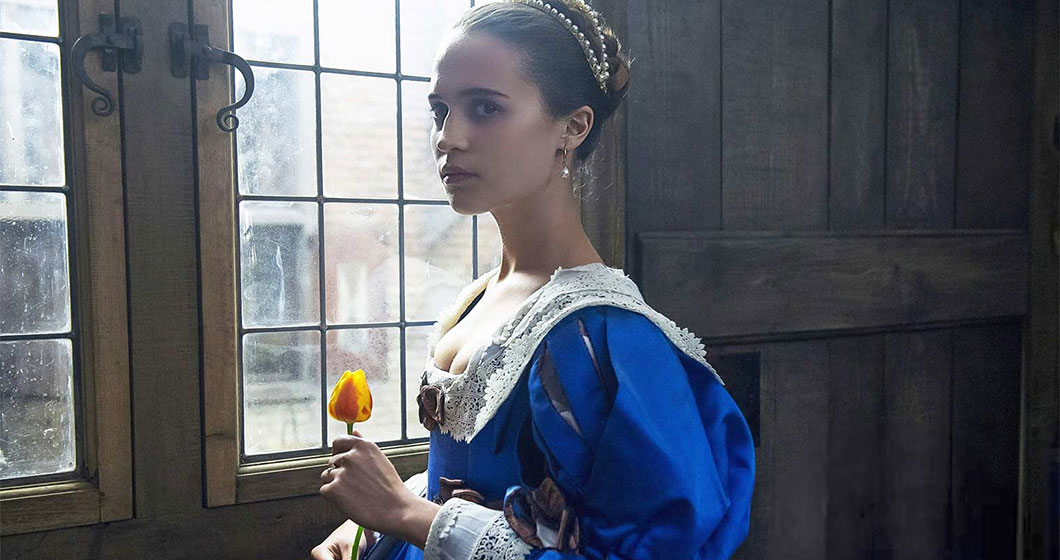Tulip Fever is less than the sum of its parts. A lot of films have this problem. Coordinating individual elements filmed and created separately is the hardest part of film-making. It’s what separates good from great, that coordination and orchestration. The frustrating part of Tulip Fever is that those parts are good. Very good. Any of them could have been the focus of a fine film. The problem is that none of them were the focus.
The film starts out following Sophia, an orphan in 17th century Netherlands, played by Alicia Vikander. She is, essentially, purchased by a wealthy merchant, Cornelis (Christoph Waltz) as a wife, but worries when she can’t get pregnant. When Cornelis commissions a portrait, she falls in love with the painter, Jan (Dane Dehaan) and begins a torrid love affair. At the same time, Cornelis’ servant, Maria, (Holliday Granger) has her own difficulties in love and pregnancy. And all their fates are affected by the tulip trading market, which was one of the first instances of the sort of mad trading bubble that would seem more at home in the 1980s.
There’s a lot going on and it would have taken an extremely skilful hand to balance the stories and harmonise them. Sadly, director Justin Chadwick is not quite up to the task. They’re just a little out of tune. It may be a case of trying to cram too much into the time. The film is based on Deborah Moggach’s book, and while it’s not enormous, it would be easy to think that barely an hour and a half isn’t enough without either cutting it down or focusing on only one aspect.
And, again, any one of those aspects would have made a great movie. Long before the painter enters the picture, the marriage between Sophia and Cornelis is an interesting one. He’s not a villain, not by any stretch. It’s a great subversion of Christoph Waltz’s astonishing charisma to have him play the faded, older version of his usual character. We see the remaining shadow of what was undoubtedly once a dashing man. He’s a surprisingly empathetic character, as is Sophia, who is at war with herself, understanding the privilege of her situation but also the pain of living in it.
Dane Dehaan’s Jan would have made a great focus. A lecherous painter seducing the subject of his work is such a perfect fit for Dehaan that it’s sort of amazing it hadn’t happened already, but the film is in such a rush that the whole relationship ends up as little more than a narrative device. His love affair with Sophia is a blur, just a series of stock scenes that two skilled actors draw a little meat from, but not enough. Same with the very unfortunate servant, Maria: an interesting story rendered rote by simply not having enough time.
Yet, there is a good movie concealed here. The segment where the Sophia and Maria must pretend, respectively, to be with and without child, is easily the film’s strongest segment. It lends itself to some French farce-esque shenanigans and allows the pair to play off each other very well, exploring what class means in this world. It also gives us more of Tom Hollander’s bizarre doctor character. It’s all too short, though. The scenes of tulip trading – which was a real phenomenon, based on their difficult importation from the Middle East – capture the insanity and addictiveness of gambling on the stock market, gaining and losing fortunes on the ephemeral. The production design, as you’d expect for a period film, is superb. Backgrounds and costumes are filled with outstanding detail and movement. This is especially good for a movie set in the 1600s, the golden age of ridiculous hats and outfits. The camera work, always closed in, reminds us of the paucity of space. Crowds are always a mirror of the character walking through them.
Yet, for these strengths, there are many weaknesses. The parallel between Sophia’s situation and the fate of tulips, both chosen and indeed commodified for beauty and offspring, is spelled out for us inelegantly. Carla Delevigne pops up for about three scenes before vanishing. Nothing wrong with having a small role, but it seems to hint at an abandoned sub plot or character. The opening narration, telling us Sophia’s backstory, flies by far too quickly. The closing monologue, which includes the line “Our stories never end, they just diverge,” is played over a sequence that cleanly wraps up every character’s fate. This montage of happy endings running counter to the narration over the top of them, sums up the film well. There was, undoubtedly, a time when that narration paid off the story’s theme, but it’s hard to know which of its several stories that was.
5/10
Tulip Fever is playing at Palace Electric.






